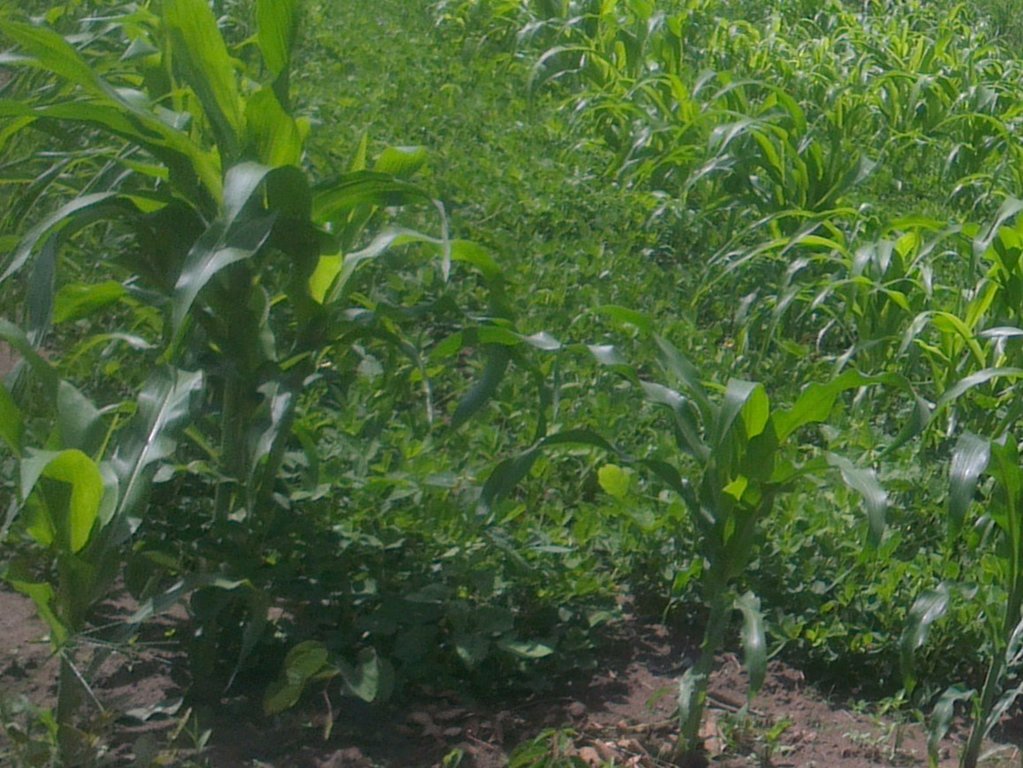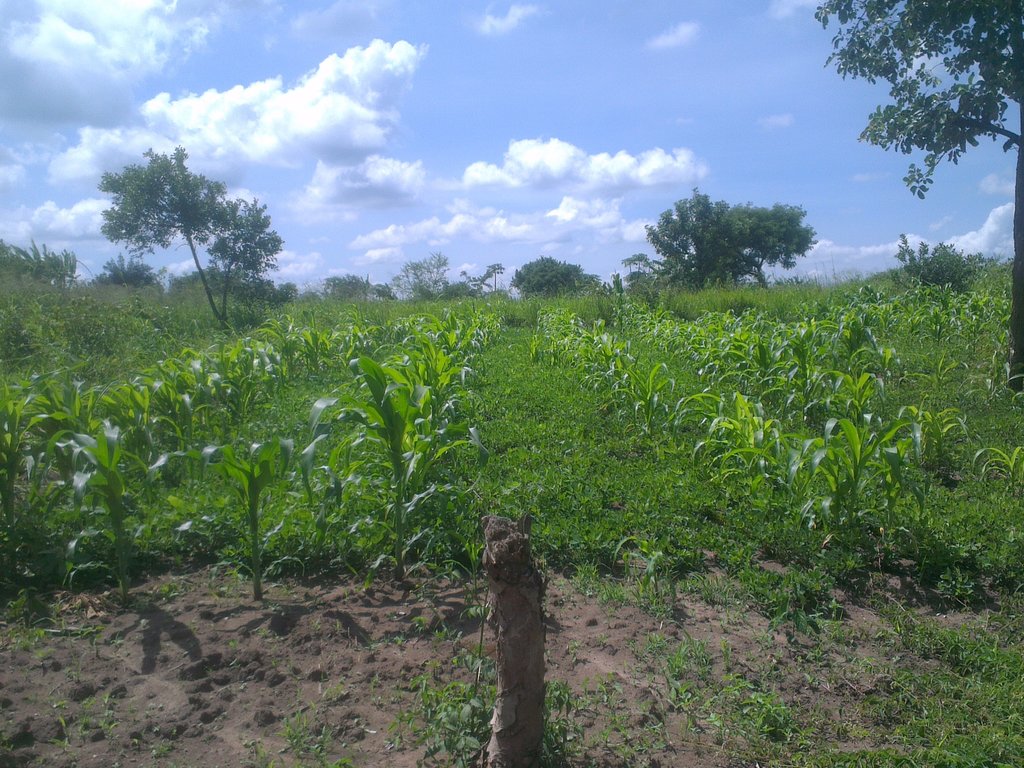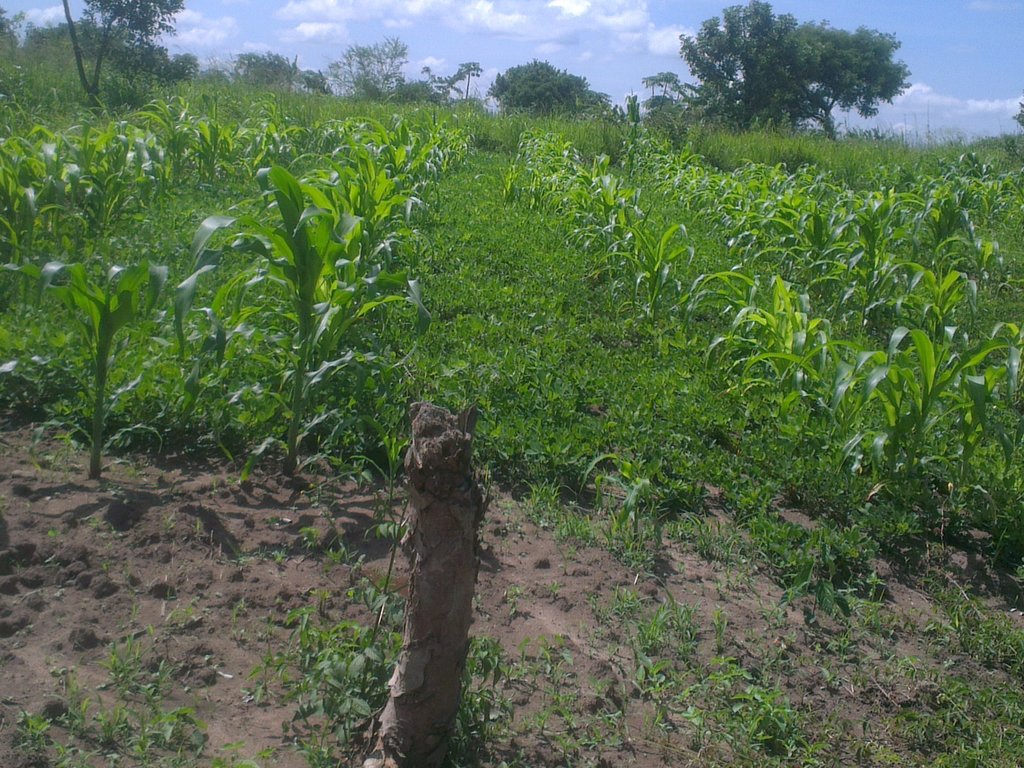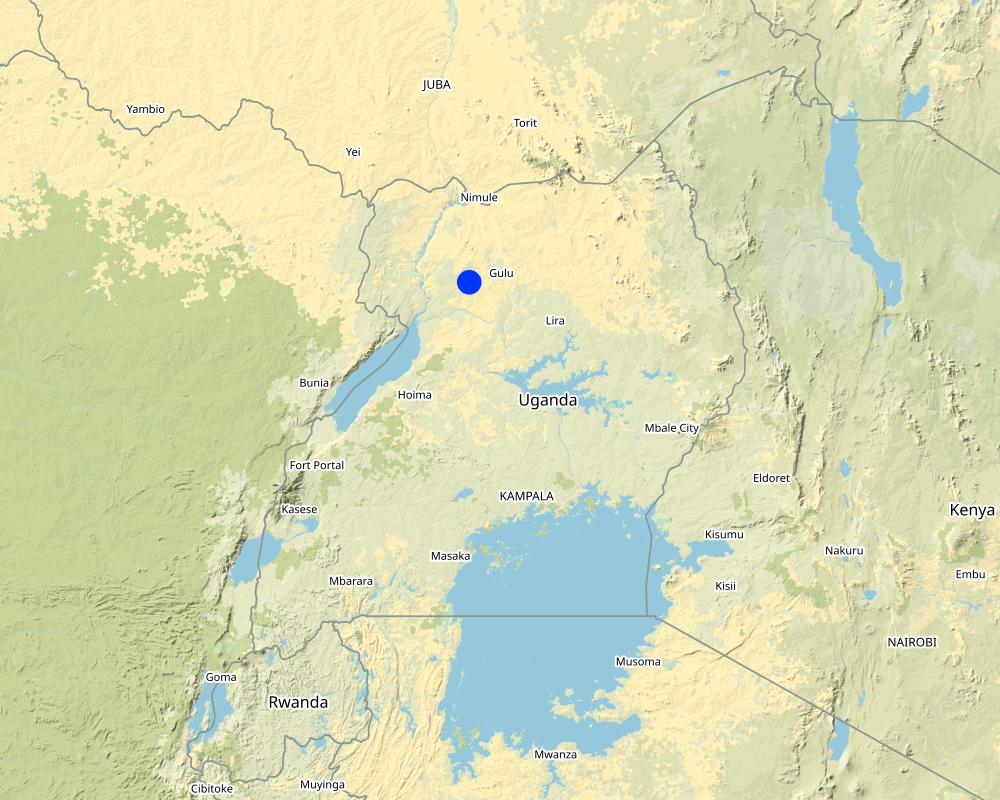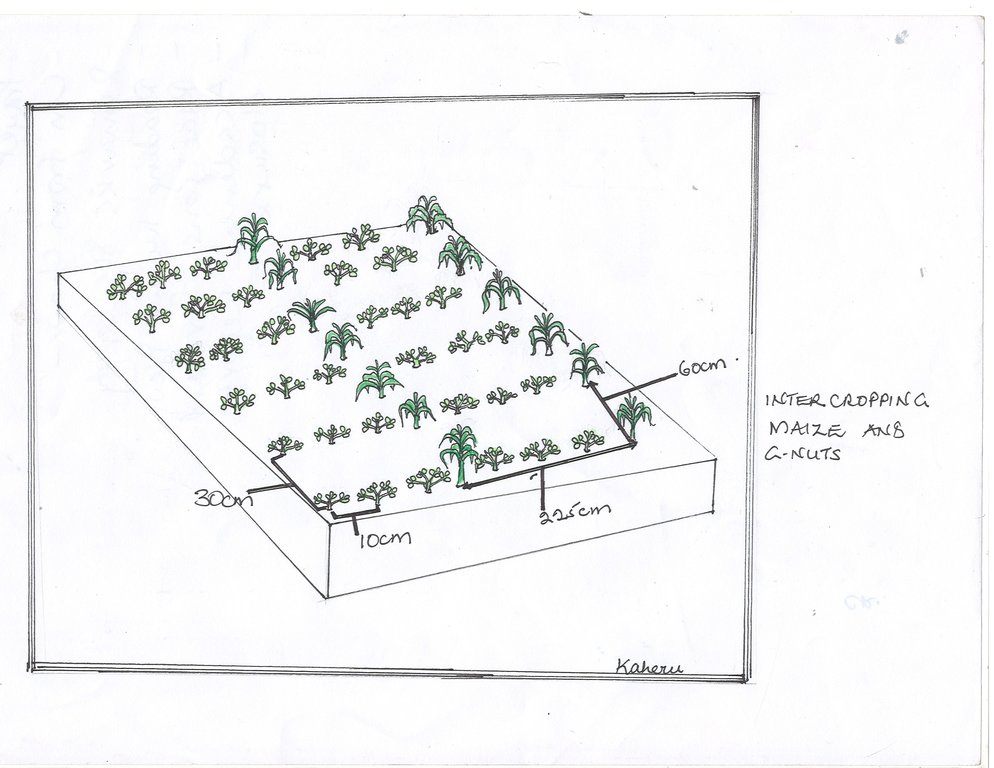Intercropping Maize and Ground Nuts for Optimum Land Utilisation, Increased Food Production, Household Income and Food Security [Uganda]
- Creation:
- Update:
- Compiler: Jalia Namakula
- Editor: Kamugisha Rick Nelson
- Reviewers: Udo Höggel, John Stephen Tenywa, Nicole Harari, Joana Eichenberger
Rub Kodi
technologies_2929 - Uganda
- Full summary as PDF
- Full summary as PDF for print
- Full summary in the browser
- Full summary (unformatted)
- Intercropping Maize and Ground Nuts for Optimum Land Utilisation, Increased Food Production, Household Income and Food Security: Aug. 18, 2022 (inactive)
- Intercropping Maize and Ground Nuts for Optimum Land Utilisation, Increased Food Production, Household Income and Food Security: Nov. 18, 2022 (public)
View sections
Expand all Collapse all1. General information
1.2 Contact details of resource persons and institutions involved in the assessment and documentation of the Technology
Key resource person(s)
land user:
Ocen Francis
Riber Farmers Group
Uganda
Name of project which facilitated the documentation/ evaluation of the Technology (if relevant)
Scaling-up SLM practices by smallholder farmers (IFAD)Name of the institution(s) which facilitated the documentation/ evaluation of the Technology (if relevant)
CDE Centre for Development and Environment (CDE Centre for Development and Environment) - Switzerland1.3 Conditions regarding the use of data documented through WOCAT
The compiler and key resource person(s) accept the conditions regarding the use of data documented through WOCAT:
Ja
1.4 Declaration on sustainability of the described Technology
Is the Technology described here problematic with regard to land degradation, so that it cannot be declared a sustainable land management technology?
Nee
Comments:
Inter cropping cereal and legume based systems aims at maximizing the production potential per unit area .
2. Description of the SLM Technology
2.1 Short description of the Technology
Definition of the Technology:
Improved maize (zea mays)-groundnuts (arachis hypogaea) optimum intercropping pattern is a technology promoted by IITA (International Institute for Tropical Agriculture) among small scale farmers through demonstrations /trials. It is promoted for improving food and income security and optimum land utilisation.
2.2 Detailed description of the Technology
Description:
The International Institute of Tropical Agriculture (IITA) has been promoting smart intercropping patterns in Nwoya District, Northern Uganda. The inter crops promoted are based on maize-legume sustainable intensification farming systems with focus on conservation farming as a technology. This technology is promoted because it reduces management inputs costs such as labour for weeding and application of fertilizers which results into sustainable systems and if efficiently used to potentially replenish natural resources.The demonstration/ trial is located in Alero Sub County, Nwoya District, which on average receives 1200 mm of rainfall annually established on a reddish soil with relatively low soil organic matter on a plot size of 180 m2 planted with groundnuts as the major crop spaced at 30cm×10cm and maize intercrop at a spacing of 225 cm×60cm, such that within every 5 lines of groundnuts one line of maize is planted.
The groundnuts (local red variety called red beauty) are locally obtained from the nearby local market, while the maize is an open pollinated variety (Longe 5) bought from the local agro input dealer. The inter crop was planted to increase productivity and reduce the risk of total crop failure.
Prior to establishment, Riber farmers group selected a site close to the road to act as there demo/plot.The plot was slashed, sprayed with glyphosate and then marked using 60-cm pegs to get the correct spacing and proper plant population. Ground nuts were planted first then the maize planted a fortnight later using the following inputs 3 kg of maize bought at UGX 1500, 15 kg of groundnuts bought at UGX 5000 and 1 litre of liquid fertiliser at UGX 15000 and 1 litre of glyphosate bought at UGX 20,000.
Inter cropping is majorly preferred by farmers because it enhances maximum utilization of land, reduces risk of total crop failure, and increases income and food security. It also acts as a means of weed management. In some inter cropping systems, the legumes act as soil cover and fix atmospheric nitrogen in the soil, and promote product diversity for food security and income generation.
However weeding an inter crops is challenging compared to weeding a pure stand and encourages competition for resources such as soil nutrients, moisture and light, which may affect crop productivity. Its therefore recommend that the farmer keep in touch with the extension worker for advisory services ( proper management, pests and diseases management)
2.3 Photos of the Technology
2.4 Videos of the Technology
Date:
28/04/2017
Location:
Alero sub-county Nwoya District
Name of videographer:
Jalia Namakula
2.5 Country/ region/ locations where the Technology has been applied and which are covered by this assessment
Country:
Uganda
Region/ State/ Province:
Northern Uganda
Further specification of location:
Bwobo nam, Alero Sub-county,Nwoya District
Specify the spread of the Technology:
- evenly spread over an area
If precise area is not known, indicate approximate area covered:
- < 0.1 km2 (10 ha)
Map
×2.6 Date of implementation
Indicate year of implementation:
2016
If precise year is not known, indicate approximate date:
- less than 10 years ago (recently)
2.7 Introduction of the Technology
Specify how the Technology was introduced:
- through projects/ external interventions
Comments (type of project, etc.):
The intercropping pattern was introduced by International Institute for Tropical Agriculture (IITA)
3. Classification of the SLM Technology
3.1 Main purpose(s) of the Technology
- improve production
- create beneficial economic impact
3.2 Current land use type(s) where the Technology is applied

Cropland
- Annual cropping
Number of growing seasons per year:
- 2
Specify:
The intercrop is done twice annually but the legumes change every season, sometimes soybean is planted instead of groundnuts (March-August and September-December)
Comments:
The demonstration site is located by the road side. It is surrounded by bush fallows and a small banana plantation (musa spp)
3.4 Water supply
Water supply for the land on which the Technology is applied:
- rainfed
Comments:
The group depends on rain fall for growing crops on this plot.
3.5 SLM group to which the Technology belongs
- integrated soil fertility management
- improved plant varieties/ animal breeds
3.6 SLM measures comprising the Technology

agronomic measures
- A1: Vegetation/ soil cover
- A2: Organic matter/ soil fertility
- A5: Seed management, improved varieties
Comments:
The groundnuts act as a soil cover and also fix nitrogen in the soil improving soil fertility
3.7 Main types of land degradation addressed by the Technology

soil erosion by water
- Wt: loss of topsoil/ surface erosion

chemical soil deterioration
- Cn: fertility decline and reduced organic matter content (not caused by erosion)

biological degradation
- Bl: loss of soil life
Comments:
The demo plot was established on an intensely cultivated area, the legumes are planted to improved soil fertility . in addition the groundnuts act as a soil cover therefore reducing soil erosion.
3.8 Prevention, reduction, or restoration of land degradation
Specify the goal of the Technology with regard to land degradation:
- prevent land degradation
Comments:
The ground nuts are inter cropped to not only increase crop diversity on the plot but to also reduce soil erosion incidence.
4. Technical specifications, implementation activities, inputs, and costs
4.1 Technical drawing of the Technology
4.2 General information regarding the calculation of inputs and costs
Specify how costs and inputs were calculated:
- per Technology area
Indicate size and area unit:
180m2
If using a local area unit, indicate conversion factor to one hectare (e.g. 1 ha = 2.47 acres): 1 ha =:
0.018 ha
other/ national currency (specify):
UGX
If relevant, indicate exchange rate from USD to local currency (e.g. 1 USD = 79.9 Brazilian Real): 1 USD =:
3680.0
Indicate average wage cost of hired labour per day:
3000/=
4.3 Establishment activities
| Activity | Timing (season) | |
|---|---|---|
| 1. | Bush clearing | January |
| 2. | Slashing and spraying | January |
| 3. | Field marking | January |
| 4. | Planting both maize and beans | March |
4.4 Costs and inputs needed for establishment
| Specify input | Unit | Quantity | Costs per Unit | Total costs per input | % of costs borne by land users | |
|---|---|---|---|---|---|---|
| Labour | Slashing | People | 15.0 | 3000.0 | 45000.0 | 100.0 |
| Labour | Ploughing | People | 15.0 | 3000.0 | 45000.0 | 100.0 |
| Labour | Field Marking | People | 15.0 | 3000.0 | 45000.0 | 100.0 |
| Labour | Planting | People | 15.0 | 3000.0 | 45000.0 | 100.0 |
| Equipment | Strings | Piece | 1.0 | 8000.0 | 8000.0 | 100.0 |
| Equipment | Planting Pegs | bundle | 2.0 | 5000.0 | 10000.0 | 100.0 |
| Equipment | Tape Measure | Piece | 1.0 | 25000.0 | 25000.0 | 100.0 |
| Plant material | Groundnuts | kg | 15.0 | 2500.0 | 37500.0 | 100.0 |
| Plant material | Longe5 (maize) | kg | 3.0 | 1500.0 | 4500.0 | 100.0 |
| Fertilizers and biocides | Liquid fertiliser (DI grow) | Ltr | 1.0 | 15000.0 | 15000.0 | 100.0 |
| Total costs for establishment of the Technology | 280000.0 | |||||
Comments:
IITA introduced the technology to the farmers group however establishment and maintenance costs were incurred by the group
4.5 Maintenance/ recurrent activities
| Activity | Timing/ frequency | |
|---|---|---|
| 1. | Weeding | April |
| 2. | Spraying | fort night |
Comments:
Weeding is done once because the ground nuts close the canopy therefore inhibiting weeds growth.
4.6 Costs and inputs needed for maintenance/ recurrent activities (per year)
| Specify input | Unit | Quantity | Costs per Unit | Total costs per input | % of costs borne by land users | |
|---|---|---|---|---|---|---|
| Labour | Weeding | people | 15.0 | 3000.0 | 45000.0 | 100.0 |
| Labour | spraying | people | 1.0 | 3000.0 | 3000.0 | 100.0 |
| Equipment | knapsacks sprayer | Piece | 1.0 | 55000.0 | 55000.0 | 100.0 |
| Total costs for maintenance of the Technology | 103000.0 | |||||
If land user bore less than 100% of costs, indicate who covered the remaining costs:
The group incurred all the costs
4.7 Most important factors affecting the costs
Describe the most determinate factors affecting the costs:
Labour is the most important factor affecting costs.
5. Natural and human environment
5.1 Climate
Annual rainfall
- < 250 mm
- 251-500 mm
- 501-750 mm
- 751-1,000 mm
- 1,001-1,500 mm
- 1,501-2,000 mm
- 2,001-3,000 mm
- 3,001-4,000 mm
- > 4,000 mm
Specify average annual rainfall (if known), in mm:
1100.00
Specifications/ comments on rainfall:
The first season starts in March-June , season 2016A and B the rains have not been sufficient, the second season starts in September -November and the dry spell begins in December - March
Agro-climatic zone
- humid
5.2 Topography
Slopes on average:
- flat (0-2%)
- gentle (3-5%)
- moderate (6-10%)
- rolling (11-15%)
- hilly (16-30%)
- steep (31-60%)
- very steep (>60%)
Landforms:
- plateau/plains
- ridges
- mountain slopes
- hill slopes
- footslopes
- valley floors
Altitudinal zone:
- 0-100 m a.s.l.
- 101-500 m a.s.l.
- 501-1,000 m a.s.l.
- 1,001-1,500 m a.s.l.
- 1,501-2,000 m a.s.l.
- 2,001-2,500 m a.s.l.
- 2,501-3,000 m a.s.l.
- 3,001-4,000 m a.s.l.
- > 4,000 m a.s.l.
Indicate if the Technology is specifically applied in:
- not relevant
5.3 Soils
Soil depth on average:
- very shallow (0-20 cm)
- shallow (21-50 cm)
- moderately deep (51-80 cm)
- deep (81-120 cm)
- very deep (> 120 cm)
Soil texture (topsoil):
- medium (loamy, silty)
Soil texture (> 20 cm below surface):
- fine/ heavy (clay)
Topsoil organic matter:
- medium (1-3%)
5.4 Water availability and quality
Ground water table:
5-50 m
Availability of surface water:
poor/ none
Water quality (untreated):
good drinking water
Is water salinity a problem?
Nee
Is flooding of the area occurring?
Nee
Comments and further specifications on water quality and quantity:
The water is drawn from the borehole and considered of good quality and is readily available
5.5 Biodiversity
Species diversity:
- medium
Habitat diversity:
- medium
5.6 Characteristics of land users applying the Technology
Sedentary or nomadic:
- Sedentary
Market orientation of production system:
- mixed (subsistence/ commercial)
Off-farm income:
- less than 10% of all income
Relative level of wealth:
- poor
Individuals or groups:
- groups/ community
Level of mechanization:
- manual work
Gender:
- women
- men
Age of land users:
- middle-aged
Indicate other relevant characteristics of the land users:
They are a farmer's group with a membership of 35(20Males and 15Females) they are all small scale farmers
5.7 Average area of land used by land users applying the Technology
- < 0.5 ha
- 0.5-1 ha
- 1-2 ha
- 2-5 ha
- 5-15 ha
- 15-50 ha
- 50-100 ha
- 100-500 ha
- 500-1,000 ha
- 1,000-10,000 ha
- > 10,000 ha
Is this considered small-, medium- or large-scale (referring to local context)?
- small-scale
Comments:
general land sizes owned by members is 2 acres
5.8 Land ownership, land use rights, and water use rights
- Customary
- Customary
Water use rights:
- communal (organized)
Comments:
The land is owned by the clan and is passed on to family members
5.9 Access to services and infrastructure
health:
- poor
- moderate
- good
education:
- poor
- moderate
- good
technical assistance:
- poor
- moderate
- good
employment (e.g. off-farm):
- poor
- moderate
- good
markets:
- poor
- moderate
- good
energy:
- poor
- moderate
- good
roads and transport:
- poor
- moderate
- good
drinking water and sanitation:
- poor
- moderate
- good
financial services:
- poor
- moderate
- good
6. Impacts and concluding statements
6.1 On-site impacts the Technology has shown
Ecological impacts
Soil
soil cover
Comments/ specify:
They act as a soil cover
6.4 Cost-benefit analysis
How do the benefits compare with the establishment costs (from land users’ perspective)?
Short-term returns:
slightly positive
Long-term returns:
slightly positive
How do the benefits compare with the maintenance/ recurrent costs (from land users' perspective)?
Short-term returns:
positive
Long-term returns:
positive
Comments:
The intercrops are an annual enterprise therefore benefts are realised in the short term. the group indicated that they planted one(1) kg of maize seed the previous season and got 200kgs after harvesting. however in this particular season the harvests were not yet made
6.5 Adoption of the Technology
- 11-50%
If available, quantify (no. of households and/ or area covered):
The group has a membership of 35 people all the group members have transffered the technology into their own farms.
Of all those who have adopted the Technology, how many did so spontaneously, i.e. without receiving any material incentives/ payments?
- 51-90%
Comments:
All the members received seed from the proceeds of the previous season from the group demo and were supposed to transfer the technology to their different individual farms.
6.6 Adaptation
Has the Technology been modified recently to adapt to changing conditions?
Nee
6.7 Strengths/ advantages/ opportunities of the Technology
| Strengths/ advantages/ opportunities in the land user’s view |
|---|
| The technology is good at Improving crop yield due to the crop, nutrients, fertility |
| Inter cropping leads to weed suppression |
| The technology controls pest and disease incidence. |
| Strengths/ advantages/ opportunities in the compiler’s or other key resource person’s view |
|---|
| Legumes act as soil cover hence reduction in soil moisture |
| Reduces risk of total crop failure. In case the drought starts early the farmer would have already harvested the legumes. |
| Improve soil fertility resulting from the legumes fixing nitrogen in the soils |
6.8 Weaknesses/ disadvantages/ risks of the Technology and ways of overcoming them
| Weaknesses/ disadvantages/ risks in the land user’s view | How can they be overcome? |
|---|---|
| Weeding in intercrops is cumbersome | weed when crops are still young |
| It is not easy to use chemical weed control in intercrops | This is overcome by spraying weeds before planting hence reducing on their vigour and also weeding early |
| sometimes the right plant population is not got reducing on the crop yields of intercrops | This is overcome by marking the correct spacing of the major crop to atleast get optimum plant population for the major crop |
| Weaknesses/ disadvantages/ risks in the compiler’s or other key resource person’s view | How can they be overcome? |
|---|---|
| some times there is competition for nutrients and water between the crops | Applying of basal nitrogenous fertilisers |
| Sometimes inter cropping may lead to entiolation and poor growth of crops | This can be overcome by planting the legume before planting the cereal. This is done to allow the legumes grow fast so as they dont get affected by too mush shade |
| Late maturing crops are usually damaged during harvesting of the early maturing crops | This is overcome by planting in rows and being careful while harvesting the early maturity crops. |
7. References and links
7.1 Methods/ sources of information
- field visits, field surveys
1
- interviews with land users
1
When were the data compiled (in the field)?
12/5/2017
7.2 References to available publications
Title, author, year, ISBN:
Effect of Summer Maize-Legume Intercropping System on Growth, Productivity, Pilli Manassa , 2018
Available from where? Costs?
Open access
7.3 Links to relevant online information
Title/ description:
Maize/peanut intercropping increases land productivity: A meta-analysis
URL:
https://www.sciencedirect.com/science/article/pii/S0378429021001544
Links and modules
Expand all Collapse allLinks
No links
Modules
No modules



